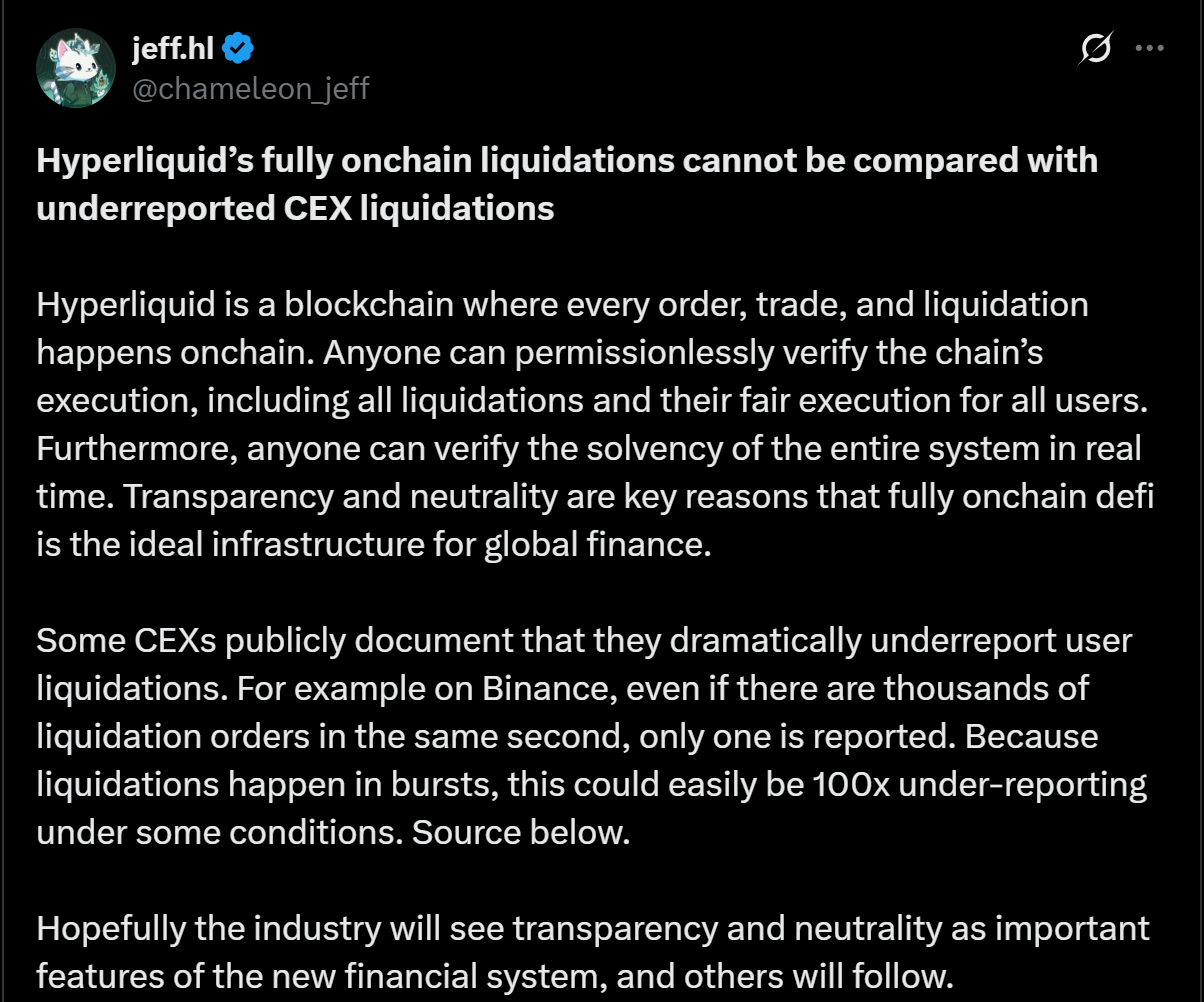- Hyperliquid ensures complete transparency by recording all transactions and liquidations on the blockchain and providing real-time verification.
- Jeff criticizes centralized exchanges, such as Binance, for underreporting liquidation events, sometimes by a factor of 100.
- The shift to decentralized, on-chain systems is necessary for creating a reliable and transparent financial ecosystem.
The founder of Hyperliquid recently blasted centralized exchanges (CEXs) for drastically underreporting liquidation events. As the future of global finance, Jeff, the founder, emphasized the importance of transparency in the cryptocurrency market and the need for fully on-chain, verifiable and neutral decentralized financial systems (DeFi). The commentary specifically highlighted how Hyperliquid’s fully on-chain strategy differs from conventional centralized platforms like Binance in terms of liquidation reporting.
Jeff claims that CEXs are unable to match the transparency of this system.

Source: X
In contrast, Jeff noted that many centralized exchanges do not provide sufficient or accurate data on liquidation events. Jeff drew attention to a critical issue with Binance, one of the largest cryptocurrency exchanges in the world.
Only one of the thousands of liquidation orders that Binance can receive in one second is made public. This inequality is not small. For traders and investors, who are unaware of the full extent of liquidations taking place on these platforms, the lack of transparency in liquidation reporting poses a serious problem.
Because liquidations typically occur in a short period of time, as Jeff noted, under-reporting can be as much as a hundredfold under certain severe circumstances. Large differences like these are worrying because they can create a false sense of market liquidity and stability.
Why transparency matters in DeFi
Two of the most important benefits of decentralized financial systems are often mentioned: transparency and neutrality. Because there is no central authority within DeFi, no organization has the ability to control or change the data displayed on the blockchain. The decentralized structure of these systems obviously provides some security, as it protects them from potential bias or manipulation that can occur in centralized organizations. All transactions, including liquidations, are guaranteed to be publicly recorded and immutable on the blockchain’s distributed ledger. Users of centralized exchanges, on the other hand, must trust that the platform will report accurate information.
The lack of transparency of centralized platforms can be especially troublesome when market volatility is high. Liquidations can occur quickly and in large quantities during these times, which can have a major effect on the market. However, traders are often unaware of the true scale of liquidations due to their underreporting. This can exacerbate market instability by creating incorrect expectations about market conditions. On the other hand, users can make better decisions in a system like Hyperliquid that is completely transparent because they have access to accurate data.
Furthermore, maintaining system trust depends on a platform’s ability to be immediately verified for solvency. For example, users can check the blockchain to ensure a DeFi platform has the liquidity needed to handle many liquidations. This provides a sense of security that is often lacking on centralized exchanges, where liquidity and solvency are occasionally manipulated or opaque. Fully on-chain systems like Hyperliquid thus provide users with an extra degree of security, promoting a more secure and reliable trading environment.
Under-reporting of liquidations: an ongoing problem in CEXs
While underreported liquidations on centralized exchanges are not a new problem, they have received increased attention recently as the industry strives for greater accountability and transparency. Centralized exchanges have long been criticized for their opaque reporting on liquidations.
While some platforms provide basic information about liquidations, the reports often fall short of capturing the full scope of events. As Jeff noted, there are situations where the difference between reported and actual liquidations can be as much as a hundred times greater. Due to this severe underreporting, traders and investors are unaware of the actual risks they face, distorting the perception of market stability.
The distortion of actual market conditions is one of the main problems with underreporting. It is challenging for traders to determine the level of risk they are exposed to in an environment where liquidations are not appropriately reported. This lack of accurate data can give investors a false sense of security during times of high volatility, when liquidation blowouts are most likely. Traders may take more risk than they can afford because they think the market is more stable than it is. The lack of transparency of these platforms hinders traders’ ability to make informed choices.
Market liquidity could be affected more broadly if underreporting of liquidations occurs. It becomes challenging for market participants to assess market depth and liquidity availability when liquidations are not accurately reported.
This can cause people to lose confidence in the market, especially when there is a lot of volatility. Full transparency about liquidations is seen by DeFi platforms like Hyperliquid as a means to build trust and ensure users have access to the most current and accurate information.


